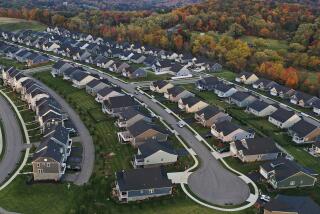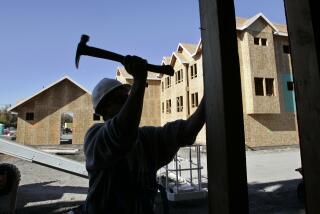Helping People Own Homes Is Sound Policy
Was it easier to solve problems in the United States years ago, or does it only seem that way?
After World War II, when veterans and their families needed housing, William Levitt & Sons devised a way to build low-cost homes on New York’s Long Island, (no basements, pre-fabricated parts), and the government found a way to help homeowners: no-down-payment Veterans Administration loans and economic policies that kept mortgage interest rates at 3%.
The result: Levittown, N.Y., and Levittown, Pa., communities that became symbols of the dream of all Americans being able to buy their own homes. And that combination of business ingenuity and government support succeeded in spreading home ownership for the next three decades.
But today we have a problem again. Young people are having trouble buying homes--a lot more trouble than their counterparts had only a decade ago. A new report by the Joint Center for Housing Studies at Harvard University finds that the rate of home ownership has declined sharply among people in their late 20s and early 30s--the prime ages for first home buyers. Home ownership is down even among those aged 35 to 39.
But it’s not lack of housing that’s to blame--it’s lack of money. First time homebuyers are having difficulty coming up with the down payment, “and have only three-fourths of the income they need to carry a mortgage at today’s rates,” says economist Glen Crellin of the National Assn. of Realtors.
Why is this happening? Because young people have been taking a beating on many fronts. House prices have risen faster than incomes in this decade. Competition for higher paying jobs by vast numbers of Baby Boom applicants, in a period of disinflation and business restructuring, held down income growth. At the same time, a side effect of Proposition 13 boosted California home prices even more: with rising taxes from all homeowners no longer available to pay for streets and sewers, communities assessed builders fees which raised costs for new or potential homebuyers.
Meanwhile, mortgage interest rates have remained relatively high. And saving for a down payment is difficult, not so much because young people are Yuppie spendthrifts, but because rents are high--a consequence of the Tax Reform Act of 1986, which removed tax incentives to build rental housing.
Mixed Feelings
So, instead of new homeowners, the decade has brought us haves and have-nots. Those who already own homes have benefited from price appreciation, and landlords have benefited from higher rents. But young would-be homebuyers have lost out. The question now is, will something be done to help them?
Congress is eager. Sens. Alan Cranston, (D-Calif.) and Alfonse D’Amato (R-N.Y.), are sponsoring an affordable-housing bill that would raise the guarantee on Federal Housing Administration mortgages to $155,000, from $101,000 and allow down payments on FHA mortgages to be only 3%. Rep. Henry Gonzalez (D-Tex.) is proposing legislation that would subsidize mortgage interest rates on a temporary and repayable basis.
But Congress is also hesitant. The lawmakers are fearful lest they create another flawed savings and loan program. They’re worried about defaults on existing VA mortgages and wary of putting a new program into the corruption-ridden Department of Housing and Urban Development.
The government, in short, has lost the old confidence that it can help the American people achieve an economic and social goal, without harmful side effects making a mess of things.
Business, by contrast, hasn’t lost its ability to build affordable housing. Inco Homes, of Upland, builds houses in Victorville and Palmdale that start at $90,000 to $135,000. “At first, home buyers endure the long commute,” says Inco owner Ira Norris, “but then find jobs closer to home.” Across the country, Hovnanian Enterprises in Red Bank, N.J., builds suburban townhomes, achieving economy through greater housing density.
And ingenuity is not dead. In West Memphis, Ark., Butler Realty came up with the idea of letting first-time home buyers earn sweat equity for part of the down payment. They can do the interior painting of their house-to-be, for instance, and earn 80 cents a square foot. That allowed one recent couple to earn $930, or 20% of the down payment on a $46,500 house.
So community planners are turning to the private sector for financial ingenuity, too. Employers in the high-priced cities will have to assist with home financing, predicts Kathleen Connell, director of the Center for Finance and Real Estate at UCLA. The Los Angeles County Development Commission even suggests that businesses will have to finance construction of affordable housing for their employees--an information age throwback to 19th Century company housing for millworkers and miners.
But business is unlikely to do much without backing from government; housing by nature is a public-private business. The stakes are high, economically and socially. A lag in first time buyers threatens industries from furniture to lawncare, and also threatens markets for existing homes. Their prices too could take a tumble if housing affordability worsens--as David Hensley of the UCLA Business Forecasting Project predicts for California in the 1990s.
And a division into haves and have-nots threatens worse than that for society. That’s why for decades, “home ownership has been given priority status,” says Denise DiPasquale, co-author of the Harvard housing study. “Do we want to alter that commitment now?” Fact is, the government already has altered that commitment by default. Now it needs to restore it.
More to Read
Sign up for Essential California
The most important California stories and recommendations in your inbox every morning.
You may occasionally receive promotional content from the Los Angeles Times.










